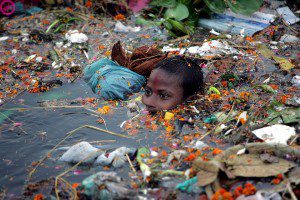Guest Writer for Wake Up World
Water is our most basic necessity and most precious resource. Unfortunately, it’s also one of the most abused. Pollution of all sorts, at all levels, has long been a problem and there are a lot of sneaky things about water pollution you might’ve never realized. It’s only when we realize the truth about water pollution that we can curb it. These 7 truly insane realities about water pollution will shock you.
1. Industrial Pollution is Turning Water into Jelly
Remember that classic Saturday Night Live skit about Swill drinking water? Well, what was originally meant to be tongue-in-cheek might not be too far off. A recent study in Canada noted that decades of industrial pollution is leeching calcium deposits from lake soil and replacing it with acid. [1] This acidic environment, along with reduced oxygen levels driven by climate change has caused native plankton to die and Holopedium, a jelly-like species of plankton that doesn’t require as much calcium, has moved in and literally made the water appear gooey. It’s very possible this invasion will affect drinking water reserves. [2]
2. Polluted Drinking Water Has Been Linked to Stillbirth
It seems that in the 60s, residents of certain Massachusetts towns were unknowingly drinking and bathing in a poison from the coatings sprayed in water pipes. The toxin wasn’t discovered in the water until 1979 simply because no one expected it to be there. The toxin in question, tetrachloroethylene, or PCE, was found by the Boston University School of Public Health to cause a higher risk of stillbirth. [3] [4] Shockingly, PCE is still used in dry cleaning and linked to cancer, memory problems, and birth defects.
3. The Amish May be Part of the Problem
No one is pointing fingers here. We’re all part of the pollution problem–even, oddly enough, the Amish. It turns out some Amish communities aren’t properly storing or collecting manure, and because of that, high levels of nitrates and E. coli are building up in Amish water wells. The EPA has warned that over 85 percent of Amish farms were in violation. [5] In addition to their own drinking water, the Amish community may be unknowingly polluting the Chesapeake Bay. In 2007, Lancaster County in Pennsylvania, a large Amish community, produced over 61 millions tons of agricultural waste. To put it into perspective, that’s more than six times what most other counties in the area produced! [6]
4. Well Water Can be Loaded with Arsenic
Arsenic, often the poison of choice in murder mysteries, can be fatal. A recent study examined 100 water wells across the Barnett Shale in north Texas and found that 30 percent of wells within a 2-mile radius of active natural gas drilling contained significantly high levels of arsenic. [7] Even “low dose” arsenic exposure can lead to cardiovascular issues. Another study even suggested high levels of exposure to arsenic poses an even greater risk among smokers. [8] [9]
5. The Penalties for Polluting Water Can be Abysmally Small
Often times the penalties huge industries face for wrong doing is laughable. The abysmally small fines companies have to pay for harming the environment tend to be more like a cost of doing business than a deterrent. Take the recent case of DuPont, a chemical giant. In 2010, the company was responsible for a series of chemical leaks, one that even led to the death of an employee. The fine? $1.3 million. [10] Pretty small for one of the largest corporations in the world. [11]
6. Environmental Safety is Not a Top Priority at the EPA
A recent watchdog report found that the EPA is not consistently enforcing regulations surrounding industrial pollution, and these toxins are finding their way into our waterways via sewage plants. [12] The agency hasn’t even updated the list of regulated sewage plant chemicals since 1981! It’s not all the EPA’s doing though; some of the blame falls with our government. Recently the House blocked portions of the Clean Water Act. [13] Hopefully things will change on that front, as it is our water and our future generations that are at stake here.
7. The Battle for Clean Water Can be Literal
America has its problems with water pollution but at the very least, most of us have the ability to turn on the tap and have relatively clean water at a moment’s notice. Not everyone in the world is so fortunate. In some places, like Iraq, there is a literal battle over resources, especially clean drinking water. [14]
What You Can Do
You can’t put your head in the sand and pretend water pollution doesn’t exist or affect you, you have to actively protect yourself.
I recommend drinking pure distilled water and adding raw organic apple cider vinegar. Avoid water in plastic bottles as it can contain BPA.
You can’t put your head in the sand and pretend water pollution doesn’t exist or affect you, you have to actively protect yourself.
What are your thoughts about water pollution? Leave a comment and share your thoughts.
– Dr. Edward F. Group III, DC, NP, DACBN, DCBCN, DABFM
Article references:
[1] Feltman, Rachel. Industrial pollution is turning lakes into ‘jelly’. The Washington Post.
[2] Jeziorski, A et al. The jellification of north temperate lakes. Proceedings B. 282 (1800).
[3] Aschengrau, Ann et al. Prenatal drinking-water exposure to tetrachloroethylene and ischemic placental disease: a retrospective cohort study. Environmental Health. 13 (72).
[4] Sullivan, Gail. In Massachusetts, contaminated drinking water linked to stillbirths. The Washington Post.
[5] Kobell, Rona. The Amish: Makers of jam, fine cabinetry, and polluted rivers. Grist.
[6] Bhanoo, Sindya. Amish Farming Draws Rare Government Scrutiny. The New York Times.
[7] McPhate, Christian. Study shows potentially unhealthy levels of arsenic in water wells across area. Denton Record-Chronicle.
[8] Blum, Deborah. A Heart Risk in Drinking Water. The New York Times.
[9] Chen, Y et al. Arsenic Exposure from drinking water and mortality from cardiovascular disease in Bangladesh: prospective cohort study. BMJ. 342.
[10] Ward, Jr., K. DuPont agrees to $1.3M in chemical leak fines. The Charleston Gazette.
[11] Loftis, Randy L. Texas drinking water tainted by natural gas operations, scientists find. The Dallas Morning News.
[12] Cama, Timothy. Auditors fault EPA for lax chemical safeguards. The Hill.
[13] Daly, Matthew. House votes to block EPA water rules. The New York Times.
[14] Pearce, Fred. Mideast Water Wars: In Iraq, A Battle for Control of Water2. Environment 360.
Previous articles by Dr. Group:
- How Turmeric Keeps You Looking Young
- 7 Toxins Harming Your Brain Right Now
- Top 5 Foods for the Pineal Gland
- 6 Things You Must Know About Colloidal Silver
- The Importance of a Kidney Cleansing Diet
- The 9 Best Herbs for Lung Cleansing and Respiratory Support
- 7 Best Foods to Support Kidney Function
- Lung Cleansing With Peppermint Oil
- Seven Facts You May Not Know About Coconut Oil
- 10 Best Herbs for Boosting Female Sex Drive
About the author:
 Dr. Edward F. Group III (DC, ND, DACBN, DCBCN, DABFM) founded Global Healing Center in 1998 and is currently the Chief Executive Officer. Heading up the research and development team, Dr. Group assumes a hands-on approach in producing new and advanced degenerative disease products and information.
Dr. Edward F. Group III (DC, ND, DACBN, DCBCN, DABFM) founded Global Healing Center in 1998 and is currently the Chief Executive Officer. Heading up the research and development team, Dr. Group assumes a hands-on approach in producing new and advanced degenerative disease products and information.
Dr. Group has studied natural healing methods for over 20 years and now teaches individuals and practitioners all around the world. He no longer sees patients but solely concentrates on spreading the word of health and wellness to the global community. Under his leadership, Global Healing Center, Inc. has earned recognition as one of the largest alternative, natural and organic health resources on the internet.
For more information, please visit Global Healing Center.

If you've ever found value in our articles, we'd greatly appreciate your support by purchasing Mindful Meditation Techniques for Kids - A Practical Guide for Adults to Empower Kids with the Gift of Inner Peace and Resilience for Life.
In the spirit of mindfulness, we encourage you to choose the paperback version. Delve into its pages away from screen glare and notifications, allowing yourself to fully immerse in the transformative practices within. The physical book enriches the learning process and serves as a tangible commitment to mindfulness, easily shared among family and friends.
Over the past few years, Wake Up World has faced significant online censorship, impacting our financial ability to stay online. Instead of soliciting donations, we're exploring win-win solutions with our readers to remain financially viable. Moving into book publishing, we hope to secure ongoing funds to continue our mission. With over 8,500 articles published in the past 13 years, we are committed to keeping our content free and accessible to everyone, without resorting to a paywall.







